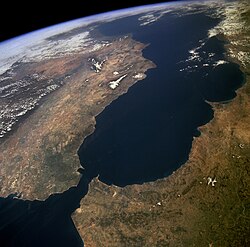The Strait of Gibraltar (Arabic: مضيق جبل طارق, Spanish: Estrecho de Gibraltar) is the strait that connects the Atlantic Ocean to the Mediterranean Sea and separates Spain from Morocco. The name comes from Gibraltar, which in turn originates from the Arabic Jebel Tariq (جبل طارق) meaning mountain of Tariq. It refers to the Ummayad Berber general Tariq ibn-Ziyad who led the Islamic conquest of Hispania in 711.[1] It is also known as the Straits of Gibraltar or STROG (Strait Of Gibraltar), the latter being in naval use.[2] There are 8 miles (13 km) of ocean separating Europe from Africa at the strait's narrowest point. The strait depth ranges between 300 and 900 meters.[3]

(on the left: Spain)

Standort
On the northern side of the Strait is Spain and Gibraltar, while on the southern side is Morocco and Ceuta, a Spanish exclave in North Africa. Its boundaries were known in antiquity as the Pillars of Hercules. There are several small islands, such as the disputed Isla Perejil, that are claimed by both Spain and Morocco.[4]
Geology
About 6 million years ago, the Strait closed, effectively turning the Mediterranean into a huge salty lake that eventually dried up, in what is known as the Messinian Salinity Crisis. The Mediterranean then turned into a lake, known as the Mediterranean Sea. At the Miocene/Pliocene boundary, approximately 5.33 million years ago, the Strait opened up for the last time, and has remained open since.[5] it is a verysarge mass of an island!!!!!!!!!!!!!!!!!!!!!!!!11
Communications
The Straits are an important shipping route from the Mediterranean to the Atlantic. There are ferries that operate between Spain and Morocco across the strait, as well as between Spain and Ceuta
Tunnel across the strait
In December 2003, Spain and Morocco agreed to explore the construction of an undersea rail tunnel to connect their rail systems. The gauge of the tunnel would be 1435mm to match the proposed construction and conversion of significant parts of the existing broad gauge system to standard gauge. [6]
Inflow and outflow
On a net basis, water continually flows eastward into and through the Strait of Gibraltar, due to an evaporation rate within the Mediterranean basin higher than the combined inflow of all the rivers that empty into it. The sill of the Strait of Gibraltar acts to limit mixing between the cold, less saline Atlantic water and the warm Mediterranean waters. The latter are so much saltier that they sink below the constantly incoming Atlantic water and form a highly saline (thermohaline, both warm and salty) bottom water, called the Mediterranean outflow. A density boundary separates the layers at about 100 m depth. It flows out and down the continental slope, losing salinity, until it equilibrates after mixing at a depth of about 1000 meters. The Mediterranean outflow water can be traced for thousands of kilometers before losing its identity.
Internal waves (waves at the density boundary layer) are common in the strait. Like traffic merging on a highway, the water flow is constricted in both directions because it must pass over a shallow submarine barrier, the Camarinal Sill. When large tidal flows enter the Strait, internal waves are set off at the Camarinal Sill as the high tide relaxes. The waves—sometimes with heights up to 100 m—travel eastward. Even though the waves occur at great depth and the height of the waves at the surface is almost nothing, they can be traced in the sunglint because they concentrate the biological films on the water surface, creating slight differences in roughness. The waves flow eastward, refract around coastal features; can be traced for as much as 150 km, and sometimes create interference patterns with refracted waves.[7]
See also
External links
- Climate Control Requires a Dam at the Strait of Gibraltar — American Geophysical Union, 1997. Accessed 26 February 2006.
- Project for a Europe-Africa permanent link through the Strait of Gibraltar — United Nations Economic and Social Council, 2001. Accessed 26 February 2006.
- Map of Morocco — Multimap.com, 2006. Accessed 26 February 2006.
- Template:Es icon Estudios Geográficos del Estrecho de Gibraltar — La Universidad de Tetuán and La Universidad de Sevilla. Accessed 26 February 2006.
- "Solitons, Strait of Gibraltar". NASA Earth Observatory. Retrieved 2006-05-24.
- "Internal Waves, Strait of Gibraltar". NASA Earth Observatory. Retrieved 2006-05-24.
References and notes
- ^ http://www.gibraltar.gov.gi/gov_depts/port/port_index.htm Gibraltar port website], retrieved June 10, 2007.
- ^ See, for instance, Nato Medals: Medal for Active Endeavor, awarded for activity in the international water of the Mediterranean and STROG.
- ^ See Robinson, Allan Richard and Paola Malanotte-Rizzoli, Ocean Processes in Climate Dynamics: Global and Mediterranean Examples. Springer, 1994, p. 307, ISBN ISBN 0792326245.
- ^ Tremlett, Giles, "Moroccans seize Parsley Island and leave a bitter taste in Spanish mouths," in The Guardian, July 13, 2002.
- ^ Cloud, P., Oasis in space. Earth history from the beginning, New York: W.W. Norton & Co. Inc., p. 440. ISBN 0393019527
- ^ Europe-Africa rail tunnel agreed BBC.co.uk
- ^ Wesson, J.C. and M.C. Gregg, "Mixing at Camarinal Sill in the Strait of Gibraltar," in Journal of Geophysical Research, Vol. 99, No. C5, 1994, pp.9847–9878.